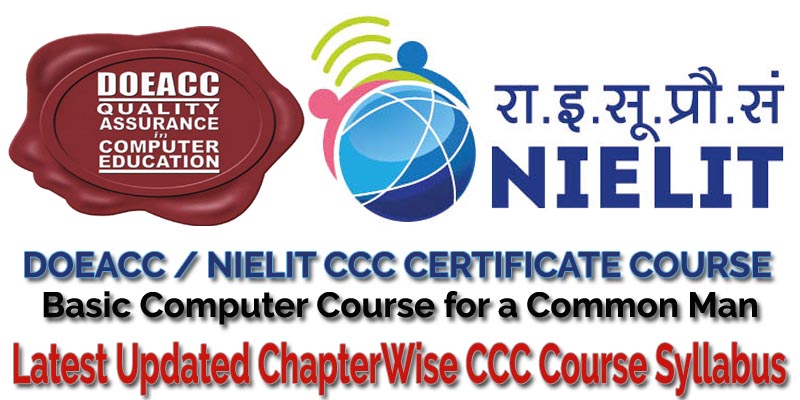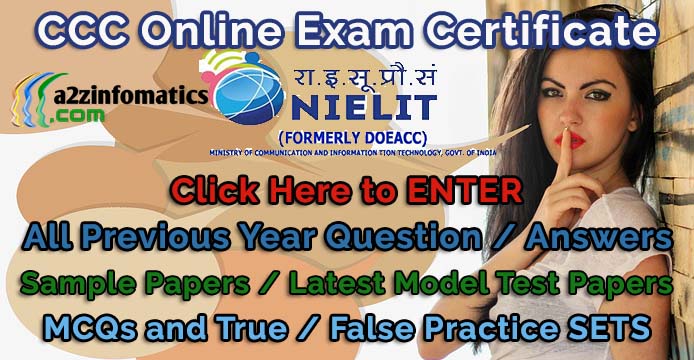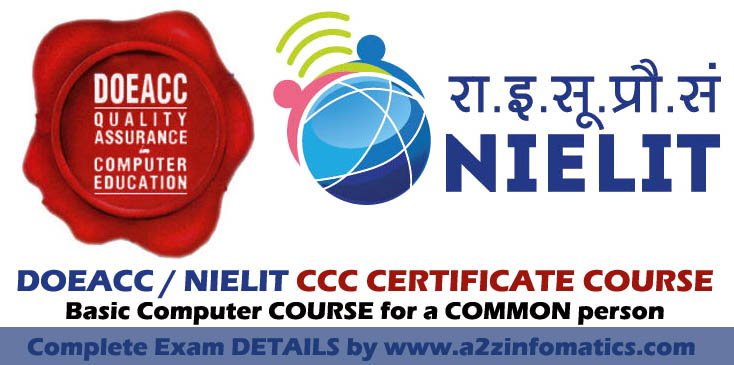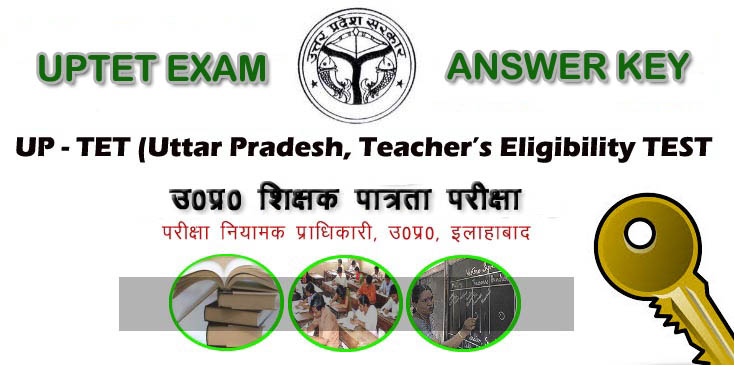In DOEACC / NIELIT CCC Course, “CCC” stands for Course on Computer Concepts. If anybody’s is dreaming about any Government JOB, then CCC Course Certificate is mandatory to apply for the Government sector JOB. If anybody wish to know complete / detailed information about the CCC Certificate Course, we had already published the same in our earlier post. You can anytime check that post to know every single little thing about DOEACC / NIELIT CCC Certificate Course.

Today, we are here with the “on demand” Chapter Wise DOEACC / NIELIT CCC Syllabus 2021 by our users, at some of the earlier CCC posts published here. Don’t get confused with the term DOEACC / NIELIT, with effect from 10-October-2011, DOEACC has been reinvented into NIELIT (National Institute of Electronics & Information Technolgy). Below is the Latest CCC Course Syllabus 2021, once you go through with each and every topic listed, we BET nobody can stop you to crack DOEACC / NIELIT CCC Certicate Course at first attempt and with good marks score.
DOEACC / NIELIT CCC Course Chapter wise Syllabus 2021 & Examination Pattern.
1)- INTRODUCTION TO COMPUTER.
(1-a) Introduction.
(1-b) Objectives.
(1-c) Computer and Latest IT gadgets.
- Evolution of Computers & its applications.
- IT gadgets and their applications.
(1-d) Basic of Hardware and Software.
… Hardware.
- Central Processing Unit.
- Input devices.
- Output devices.
- Computer Memory and storage.
… Software.
- Application Software.
- Systems Software.
- Utility Software.
- Open source and Proprietary Software.
- Mobile Apps.
(1-e) Summary.
(1-f) Model Questions and Answers.
2)- Introduction to Operating System.
(2-a) Introduction.
- Objectives.
(2-b) Operating System.
- Basics of Operating system
- Operating Systems for Laptop and Desktop.
- Operating system for mobile phone and tablets.
(2-c) User Interface for Desktop and Laptop.
- Task Bar.
- Icons and shortcuts.
- Running an Application.
(2-d) Operating System Simple Setting.
- Using Mouse and Changing its Properties.
- Changing System Date and Time.
- Changing Display Properties.
- To Add or Remove Program and Features.
- Adding, Removing & Sharing Printers.
(2-e) File and Folder Management.
(2-f) Types of file Extensions.
(2-g) Summary.
(2-h) Model Questions and Answers.
3)- WORD PROCESSING .
(3-a) Introduction.
(3-b) Objective.
(3-c) Word Processing Basics.
- Opening Word Processing Package.
- Title Bar, Menu Bar, Toolbars & Sidebar.
- Creating a New Document.
(3-d) Opening and Closing Documents.
- Opening Documents.
- Save and Save As.
- Closing Document.
- Using The Help.
- Page Setup.
- Print Preview.
- Printing of Documents.
- PDF file and Saving a Document as PDF file.
(3-e) Text Creation and manipulation.
- Document Creation.
- Editing Text.
- Text Selection.
- Cut, Copy and Paste.
- Font, Color, Style and Size selection.
- Alignment of Text.
- Undo & Redo.
- AutoCorrect, Spelling & Grammar.
- Find and Replace.
(3-f) Formatting the Text.
- Paragraph Indentation.
- Bullets and Numbering.
- Change case.
- Header & Footer.
(3-g) Table Manipulation.
- Insert & Draw Table.
- Changing cell width and height.
- Alignment of Text in cell.
- Delete / Insertion of Row, Column and Merging & Splitting of Cells.
- Border and Shading.
(3-h) Mail Merge.
(3-i) Shortcut Keys.
(3-j) Summary.
(3-k) Model Questions and Answers.
4)- SPREAD SHEET.
(4-a) Introduction.
(4-b) Objectives.
(4-c) Elements of Spread Sheet.
- Creating of Spread Sheet.
- Concept of Cell Address [Row and Column] and selecting a Cell.
- Entering Data [text, number, date] in Cells.
- Page Setup.
- Printing of Sheet.
- Saving Spreadsheet.
- Opening and Closing.
(4-d) Manipulation of Cells & Sheet.
- Modifying / Editing Cell Content.
- Formatting Cell (Font, Alignment, Style).
- Cut, Copy, Paste & Paste Special.
- Changing Cell Height and Width.
- Inserting and Deleting Rows, Column.
- AutoFill.
- Sorting & Filtering.
- Freezing panes.
(4-e) Formulas, Functions and Charts.
- Using Formulas for Numbers (Addition, Subtraction, Multiplication & Division).
- AutoSum.
- Functions (Sum, Count, MAX, MIN, AVERAGE).
- Charts (Bar, Pie, Line).
(4-f) Summary.
(4-g) Model Questions and Answers.
Genuine CCC Study Material is Available now.

5)- Presentation.
(5-a) Introduction.
(5-b) Objectives.
(5-c) Creation of Presentation.
- Creating a Presentation Using a Template.
- Creating a Blank Presentation.
- Inserting & Editing Text on Slides.
- Inserting and Deleting Slides in a Presentation.
- Saving a Presentation.
(5-d) Manipulating Slides.
- Inserting Table.
- Adding ClipArt Pictures.
- Inserting Other Objects.
- Resizing and Scaling an Object.
- Creating & using Master Slide.
(5-e) Presentation of Slides.
- Choosing a Set Up for Presentation.
- Running a Slide Show.
- Transition and Slide Timings.
- Automating a Slide Show.
(5-f) Providing Aesthetics to Slides & Printing.
- Enhancing Text Presentation.
- Working with Color and Line Style.
- Adding Movie and Sound.
- Adding Headers, Footers and Notes.
- Printing Slides and Handouts.
(5-g) Summary.
(5-h) Model Questions and Answers.
6)- INTRODUCTION TO INTERNET AND WWW.
(6-a) Introduction.
(6-b) Objectives.
(6-c) Basic of Computer Networks.
- Local Area Network (LAN).
- Wide Area Network (WAN).
- Network Topology.
(6-d) Internet.
- Concept of Internet & WWW.
- Applications of Internet.
- Website Address and URL.
- Introduction to IP Address.
- ISP and Role of ISP.
- Internet Protocol.
- Modes of Connecting Internet (Hotspot, WiFi, LAN Cable, Broadband, USB Tethering).
- Identifying and uses of IP/MAC/IMEI of various devices.
(6-e) Popular Web Browsers (Internet Explorer/Edge, Chrome, Mozilla Firefox, Opera etc.)
(6-f) Exploring the Internet.
- Surfing the web.
- Popular Search Engines.
- Searching on Internet.
- Downloading Web Pages.
- Printing Web Pages.
(6-g) Summary.
(6-h) Model Questions and Answers.
7)- E-mail, Social Networking and eGovernance Services.
(7-a) Introduction.
(7-b) Objectives.
(7-c) Structure of E-mail.
(7-d) Using E-mails.
- Opening Email account.
- Mailbox: Inbox and Outbox.
- Creating and Sending a new E-mail.
- Replying to an E-mail message.
- Forwarding an E-mail message.
- Searching emails.
- Attaching files with email.
- Email Signature.
(7-e) Social Networking & e-Commerce.
- Facebook, Twitter, LinkedIn, Instagram.
- Instant Messaging (WhatsApp, Facebook Messenger, Telegram).
- Introduction to Blogs.
- Basics of E-commerce.
- Netiquettes.
(7-f) Overview of e-Governance Services like Railway Reservation, Passport, eHospital [ORS]
(7-g) Accessing e-Governance Services on Mobile Using “UMANG APP”.
(7-h) Digital Locker.
(7-i) Summary.
(7-j) Model Questions and Answers.
8)- DIGITAL FINANCIAL TOOLS AND APPLICATIONS.
(8-a) Introduction.
(8-b) Objectives.
(8-c) Digital Financial Tools.
- Understanding OTP [One Time Password] and QR [Quick Response] Code.
- UPI [Unified Payment Interface].
- AEPS [Aadhaar Enabled Payment System].
- USSD[Unstructured Supplementary Service Data].
- Card [Credit / Debit].
- eWallet.
- PoS [Point of Sale].
(8-d) Internet Banking.
- National Electronic Fund Transfer (NEFT).
- Real Time Gross Settlement (RTGS).
- Immediate Payment Service (IMPS).
(8-e) Online Bill Payment.
(8-f) Summary.
(8-g) Model Questions and Answers.
9)- Overview of Futureskills & Cyber Security.
(9-a) Introduction to Futureskills.
(9-b) Introduction to-
- Internet of Things (IoT).
- Big Data Analytics.
- Cloud Computing.
- Virtual Reality.
- Artificial Intelligence.
- Social & Mobile.
- Blockchain Technology.
- 3D Printing/ Additive Manufacturing.
- Robotics Process Automation.
(9-c) Cyber Security.
- Need of Cyber Security.
- Securing PC.
- Securing Smart Phone.
(9-d) Summary.
(9-e) Model Questions and Answers.
Final Notes:
That’s all we have for the CCC Syllabus 2021 section, please go through with each and every topic listed in the DOEACC / NIELIT CCC Exam Syllabus 2021. Best of luck for your CCC Examination. If you need any more info about the Online CCC Certificate Exam, don’t hesitate to check our previous post DOEACC / NIELIT CCC Certificate Course.





